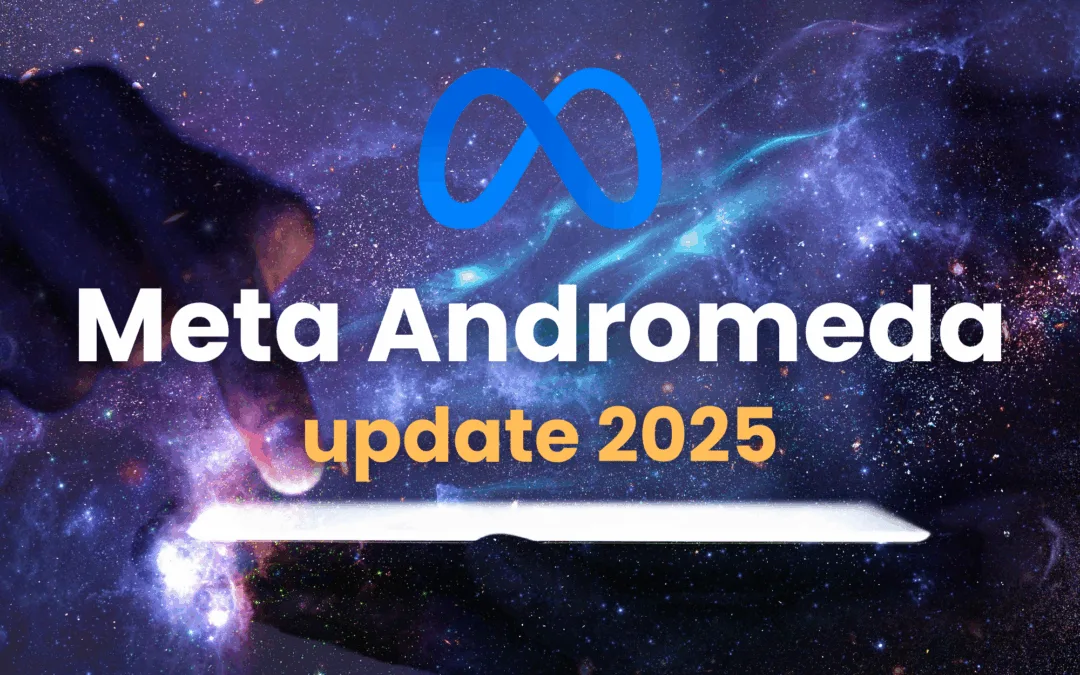“My ROAS died overnight.” “CPA doubled.” “Andromeda killed my campaigns.”
You’ve probably heard variations of these complaints everywhere. And honestly, they’re not surprising. Meta announced Andromeda back in December 2024, but most advertisers didn’t get the update until recently. And when it finally rolled, performance tanked for anyone still running old-school setups.
But here’s the part most people miss: Meta Andromeda is a new system built to reward personalisation, creative variety, and broader signals. And that’s the good news. Once you understand what changed and how to adapt, you can use the Andromeda update to get ahead while everyone else is busy blaming the algorithm and clinging to strategies that no longer work.
Contents
What is Meta Andromeda (Explained Without the Tech Jargon)?
Let’s understand Andromeda with a Netflix analogy.
If you like comedy, Netflix will not just say, “Cool, here’s every comedy ever made.” Instead, the Netflix algorithm looks at what you watched, skipped, or binged last weekend and recommends specific comedies tailored to your taste.
Andromeda does the same thing for your ads.
Before Andromeda, Meta grouped people into broad audience buckets. If someone fit into “fitness enthusiasts aged 25–40,” they all saw the same type of ads. Now, the system picks a unique ad for each individual based on their behaviour and buying journey.
Recommended Reading:
If you want a deeper look at how audience profiles work, you may find this helpful: buyer persona guide
What does that mean? It means:
Meta Andromeda = hyper-personalised delivery + lightning-fast decisions + the ability to process thousands of creative variations and match the right one to the right person at the right time.
And if you want to compare this shift with other Meta systems, check this breakdown of Advantage+ vs manual
Why Meta Created Andromeda & What It Means for Advertisers
Some advertisers think Meta rolled out Andromeda to make results worse or destroy smaller brands. But think about it: Meta earns money when advertisers get sales and keep spending. So if everyone’s results suddenly fell apart, budgets would drop fast – and Meta would definitely not want that. So no, Andromeda is not launched to make your ads perform worse.
Here’s why Meta launched Andromeda:
- Personalisation: Individual-level matching means better user experience and better advertiser results. When someone sees an ad that speaks to them, they engage (when they engage, you get sales).
- Scale: Advertisers now create thousands of AI-generated ad variations using Advantage+ Creative, Meta’s image tools, and external tools like HeyGen or ChatGPT. The old system couldn’t keep up with that kind of volume. Andromeda can.
The previous grouping-based system worked well when you had 5 ads and broad audience buckets. But it left money on the table because it couldn’t predict individual behaviour accurately enough. Andromeda closes that gap. It processes thousands of creative variations, predicts which one will resonate with each person, and serves it instantly. That’s why Meta built it. Not to sabotage your campaigns. But to handle the scale and speed that modern advertising demands.
Why Andromeda Worked for Some Brands & Backfired for Others
If Andromeda is an upgrade, why did so many advertisers see their results tank?
Fair question. Here’s the answer:
First, some of it has nothing to do with Andromeda. Seasonal effects like Q4 CPM spikes, industry cycles, competitive shifts… all of that plays a role. If your niche got more crowded or your market cooled down, that’ll hurt performance no matter the algorithm.
Other than that, another reason is:
You’re running an outdated ad structure under a system built for personalisation.
Yes. Andromeda works by matching individual people with individual ads… but you’re only feeding it 3 ads with narrow interest targeting, what’s it supposed to do? It doesn’t have enough options to personalise. So your performance drops.
On the flip side, advertisers who updated their setup saw the opposite. Many of the brands we run performance marketing for actually improved after the update because their structures aligned with how Andromeda works. With that in mind, let’s see what you need to change to help the Andromeda algorithm perform at its best.
The 4 Changes You Must Make to Your Meta Ads Strategy After Andromeda
1/ Increase Creative Volume
You need 15–20+ high-quality ads. And not slight colour tweaks or one-word headline changes. Literally different ads. The reason? More ads give more options for Andromeda to match the right ad to the right person.
2/ Increase Creative Diversity
Only volume isn’t enough. You need variety, too. So, create ads with different:
- Awareness-level messages (some people don’t know the problem exists)
- Pain points (what keeps them up at night)
- Desires (what they want their life to look like)
- Audience avatars (a 25-year-old founder thinks differently than a 45-year-old VP)
- Hooks and angles (not just visual tweaks)
Different angles. Different hooks. Different pain points. That’s what Andromeda needs to match people accurately.
3/ Let Meta Handle Sequencing
Andromeda figures out who needs what message by looking at real user behaviour. So instead of splitting everything into separate TOF, MOF, and BOF campaigns, you can place different funnel-stage creatives inside one ad set and let the system sort it out.
- Someone who’s never heard of you will get an intro-style ad.
- Someone who checked your pricing page yesterday will get a direct conversion push.
You don’t need to force people through a funnel anymore – Andromeda will sort automatically.
4/ Trust Broad Targeting
Granular interest stacking weakens the system.
When you layer 15 interests and pile on exclusions, you’re limiting what Andromeda can find. You’re saying “only look here” when it could be finding high-intent buyers you didn’t know existed. So drop the interest stacking. Stop excluding everyone. And run 2–3 strong ad sets with enough budget for the system to learn.
Conclusion
You don’t need to panic about Meta Andromeda. You just need to understand how it works and what it rewards. Andromeda rewards variety, clarity, and trust in the system. It punishes advertisers clinging to micro-targeting and outdated funnel structures. If you increase creative volume, add diversity, consolidate your ad sets, and go broad with targeting, you’ll see results improve. If you keep doing what worked two years ago, you’ll keep bleeding budget.
The choice is yours.
So don’t wait. Pick one change from this list. Start testing today. And build from there.
Talking of Meta ads:If you need help adapting your campaigns to Andromeda, scaling creative production, or building a full performance marketing strategy that actually works in 2025… you can reach out to our Brandshark team. We’re a digital marketing agency in Bangalore, and we’ve helped D2C brands, SaaS companies, and startups improve ROAS and scale profitably over the years. Get in touch with us today.

